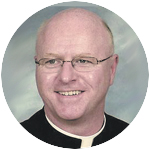
Msgr. Joseph Prior
(Readings of the Holy Mass – Twenty-first Sunday in Ordinary Time)
“… And upon this rock I will build my church, and the gates of the netherworld shall not prevail against it,” Jesus says to Simon, now Peter.
Jesus’ declaration comes after he poses several questions to his disciples. He is using the questions as an opportunity to enter more deeply into the reality of His identity and His mission.
Jesus begins, “Who do the people say that I am?” The disciples respond citing several of the great prophets. Jesus is a prophet but much more so the answers are insufficient to properly answer the question. So he turns to them, “You do you say that I am?”
He asks all but it is Simon Peter alone who answers the question, saying “You are the Christ, the Son of the living God.” Peter makes his remarkable profession of faith. Other apostles have or will make professions of faith.
Nathaniel in his first encounter with Jesus says, “Rabbi, you are the Son of God, the King of Israel.” Thomas after encountering Jesus, risen from the dead, says, “My Lord and my God.”
With Simon Peter’s profession, something is different, something unique. Jesus realizes this and so he says to Simon Peter, “Blessed are you, Simon son of Jonah. For flesh and blood has not revealed this to you, but my heavenly Father.” Thus, Peter has a distinct role in the salvific mission of Christ. The apostles all have a role in that mission but Peter’s is unique.
And so, Jesus says: “And so I say to you, you are Peter, and upon this rock I will build my church, and the gates of the netherworld shall not prevail against it. I will give you the keys to the kingdom of heaven. Whatever you bind on earth shall be bound in heaven; and whatever you loose on earth shall be loosed in heaven.”
The commission places Peter in a leadership role among the twelve. He will be the footing for the Church, the Body of Christ. Jesus will entrust him with great responsibility — a share in His mission.
Jesus has been proclaiming the Kingdom of God (or the Kingdom of heaven as it is termed in the Gospel According to Matthew). Peter is now given the keys. In Christian symbolism, the “keys” are one of the symbols for Peter as is the inverted cross. If you visit Churches and museums with collections of Christian art, these symbols are one of the ways to identify the person portrayed.
Peter was one of the first people invited to follow Jesus. He was a fisherman but left everything he had because he had found something more, a relationship with Christ. He was with Jesus from the beginning of the mission. He came to know him first as a teacher, miracle worker, prophet then as a friend and brother; and ultimately as Lord. Peter was not perfect, he will still deny the Lord three times then flee when he is crucified. Yet God chooses this man for a special role.
Peter’s profession of faith is the correct answer to Jesus’ question on His identity. He is more than a prophet, He is the Christ. He is the Son of God. Peter’s understanding of this will have to develop.
In the next scene of the Gospel, we will find Jesus teaching Peter and the others about the cross. We will see in that scene that Peter will have to come to an understanding of what that cross means, not only in Jesus’ life, but in his own as well. The cross is central to salvation, and to discipleship, and to apostleship. It will pervade his whole life.
Peter’s role of leadership has been passed on through the millenia through the Seat of Rome. Peter was the first Bishop of Rome. His successors have continued His leadership role down to the present day.
The Church has battled endless troubles over the 2,000 years from forces from without and from within, the “gates of the netherworld” have not prevailed.
Pope Francis fills the role of Peter today. He is charged with leading the Church, shepherding Her in the footsteps of Peter, in the footsteps of Christ. Gathering each week around the altar we offer prayers for many things.
One of the people we pray for by name is Pope Francis. He has enormous responsibility and our prayers for him provide strength for his ministry.
Saint Peter, after he was crucified (upside down for he did not feel worthy to die the same way Jesus did), was buried in Rome in a cemetery not far from where he was crucified. It was on the Vatican hill on the far side of the Tiber. A small shrine was erected there to mark the tomb. Christians from the first century on visited that site to prayer for Peter’s intercession and to make a profession of faith.
In the fourth century a large church was built over the cemetery. The church was named in honor of Peter.
In the sixteenth century, the original church was demolished and over the next 100 plus years a new one was built on top of the site, the present-day Saint Peter’s Basilica.
Surrounding the lower level of the dome, which is built directly over his tomb, are Jesus’ words to Peter from today’s gospel. They are written in nine feet high letters both in Latin and Greek. Over the past two thousand years, pilgrims visiting the tomb below will mark the occasion with a prayer. They make a profession of faith. Most commonly today they will say the Creed.
As we say the creed today at Mass, let us be inspired by Peter’ profession and enlivened by his witness.
***
Msgr. Joseph Prior is pastor of Our Lady of Grace Parish, Penndel, and a former professor of Sacred Scripture and rector of St. Charles Borromeo Seminary.



Share this story